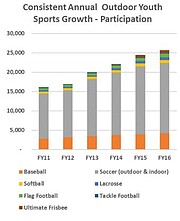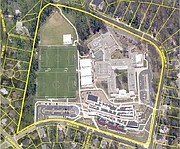Opposition to Williamsburg lights attended the County Board meeting dressed in green. Photo contributed
No one was happy on Saturday.
Roughly 60 speakers came out to the County Board meeting on Sept. 16 to show their support or opposition to lighting the athletic fields near Williamsburg Middle School. Some were local residents dressed in all green to show their opposition to another encroachment onto the neighborhood. Others were parents with their children or recreational park users who took the stand to lament the limited current lack of options for evening sports and activities. Many on both sides expressed a hope that there would be some definitive resolution out of the Saturday meeting.
There was not.
The County Board voted unanimously to delay any decision on the Williamsburg lights.
But while the members of the County Board expressed disappointment that further progress wasn’t reached over six hours of discussion, the debates over the lights have been ongoing for at least four years. The debate over lights at Williamsburg goes back to 2013, when a working group was established to evaluate whether or not lights would be feasible at that field. A report by the working group noted that the use of recreational facilities, particularly those requiring a rectangular field, have continued to increase over the years, while accessibility of field space has remained mostly stagnant. Additionally, nearly all of the rectangular fields in Arlington are in central or south Arlington, leaving north Arlington underserved.
“What is appropriate in one neighborhood is not appropriate in another,” said Pamela Stapleton.
Stapleton was one of several residents who shared concerns not just about the excess light flooding their living rooms, but the noise more late night activities would bring to their quiet neighborhood.
But those who use Arlington’s fields said the desperate need for additional hours was being felt by the local community.
“I understand and appreciate the [neighborhood’s] concerns, but we can't let nimbyism prevail,” said Francesca O’Reilly. “As neighbors and friends, we all need to give a little bit, compromise inherently means we’re all a little bit unhappy.”
Nimbyism refers to the phrase NIMBY, or “not in my backyard,” which refers to a mentality by local communities that they aren't opposed to development for others but don't want it to happen near them.
Both sides argued that their side was being mischaracterized by the other.
“This is not nimbyism,” said Nancy Delogu, who noted that all three of her children had played soccer locally. “This community accepted a new school.”
Delogu pointed out that the local community had accepted the Discovery School despite the fact that the facility had been approved with fewer parking spaces than required in that neighborhood. But County Board Chair Jay Fisette said he remembered the community’s view on the Discovery School differently, saying at the time that many in the community had opposed the school and had only come to accept it after meeting with the county and being willing to accept project modifications. Fisette, and others on the board, pointed out that this discussion about neighborhood space vs broader community needs isn't new. The working group’s report on the lights notes that this conflict is very characteristic of land use controversies ongoing across the county.
“In many ways this is a classic land use issue related to growth in Arlington,” stated the working group report. “Should growth in the county adversely impact a given set of residents? Or, flipped around, should a small number of residents inhibit growth that benefits a far larger number of residents?”
Fisette admitted that going into the County Board meeting, he felt comfortable with approving the lights on the field. But during the discussions, Fisette and other members of the County Board had concerns about the impact on local residents and questioned whether it was the local community that would really be getting the most use from the new facilities.
While the majority of the County Board still seemed favorable to the idea of lights on the Williamsburg field, there were still enough concerns to merit further study.
“I don’t want to change the nature of the neighborhood,” said County Board member Libby Garvey. “Every decision we make, we look at what is the good and for whom at what cost? We’ve established what a lot of the good is, for whom we can pick that up, at what cost? It’s the cost to the neighborhood. I realize you’re bearing that costs. The question is how bad is that cost, and with proper mitigation, I don’t think it will be that bad.”
The board directed County Manager Mark Schwartz to bring the board a list of tiered options to achieve increased field capacity of facilities. The board also direct Schwartz to initiate a study to consider amendments to the zoning ordinance that would allow light poles above 68 feet.
“Sometimes when you get to the end and no one is really happy, you think you succeeded,” said Fisette. “Somehow that is eluding me. I can see there’s disappointment in the whole room all the way around. A lot of us wanted it to be over, to get the lights or not get the lights.”
For most on the County Board, despite the delay, it’s still clear that Williamsburg field lights is a likely end point.
“The conversation is clumsy, the language is probably imperfect, but the direction is clear and I think that’s the most important thing for us to move forward in a way,” said County Board member Christian Dorsey. “I do think we are moving forward, though we haven’t reached a point with a final, determinative position.”


